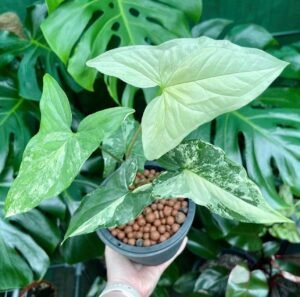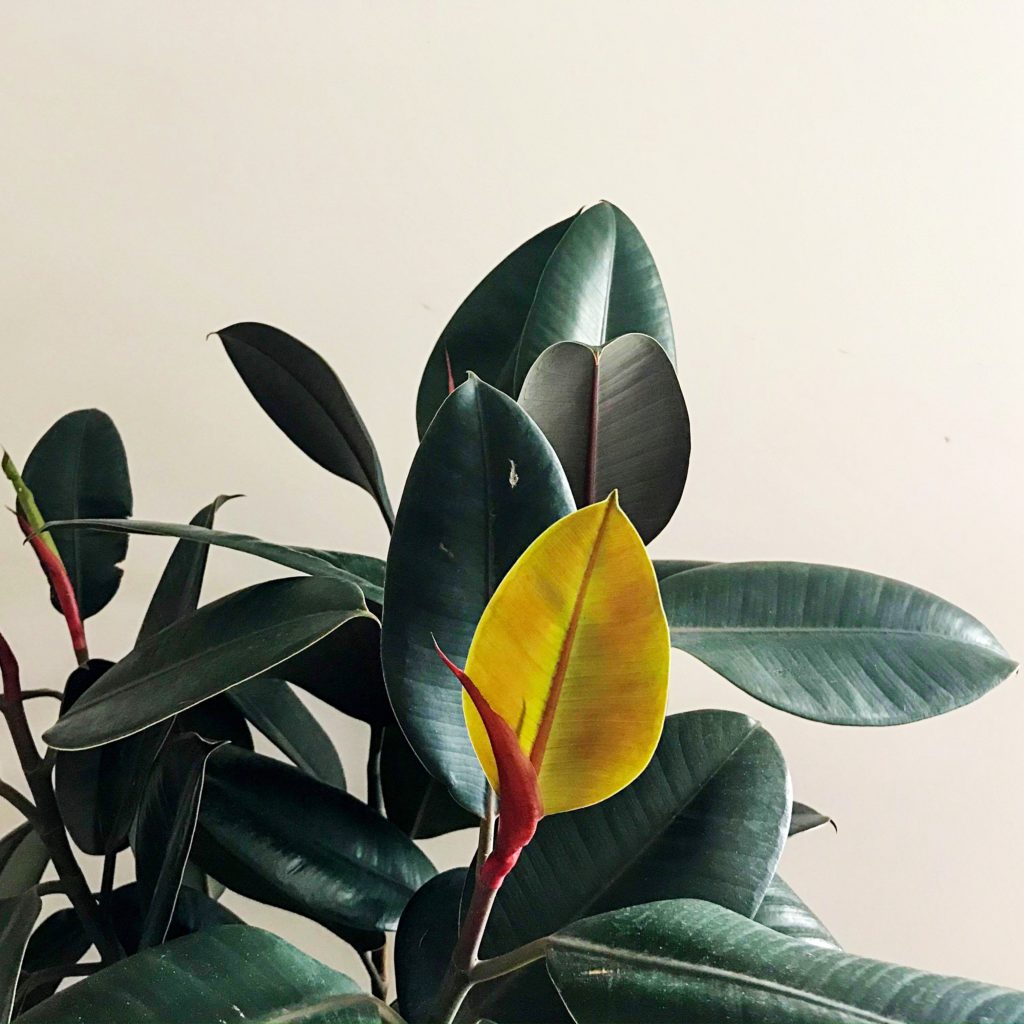Syngonium Podophyllum Albo-Variegata a.k.a Variegated Arrow-head Vine or Syngonium Fantasy
Syngonium Fantasy is undoubtedly one of the prettiest and most sought after Syngonium varieties. With its recent increase in popularity, prices have exploded with plants and cuttings ranging in prices typically starting from $20 all the way up to $150! The care requirements for this plant are very similar to other Syngoniums, so if you are already growing other varieties, these will fit in perfectly.

Syngonium Fantasy Quick Overview
| Full Size | 1.8 metres |
| Light | Bright indirect |
| Temperature | 60ºF – 95ºF (15ºC – 35ºC) |
| Humidity | High (60% – 70%) |
| Cost | $$ – $$$ |
| Care Level | Easy |
| Toxicity | Toxic |
Size
Syngonium Fantasy can be grown in a variety of ways; including as a small compact plant, bushy plant or as a climbing plant up a pole or trellis. The typical full grown size of this plant when kept as a trained vine is around 1.8 metres/ 6foot in length.
In the correct conditions, this plant can be quite a fast growing. As the plant starts to vine, you can grow it up a totem, let it train or you cut them off with a pair of pruners. You can then propagate these cuttings if cut correctly below the node. The cuttings will root fairly quickly in either water, spaghnum moss, LECA or moist soil. Once established they can be planted back in with the original pot to create a bushy effect or you can keep them as a whole new plant.
Syngonium Fantasy Light Requirements
In order to keep the beautiful white variegated foliage, Syngonium Fantasy need to be housed in a spot with bright indirect light. It’s best to try and avoid full sun as the harsh rays will burn the leaves. However, these plants can also tolerate medium lighting as well. A sign that your plant is getting too much light is burnt or bleached leaves.
When positioned in a spot with low light, foliage will start to lose the variegation and the leaves will start to grow further apart. This can be resolved by changing the position of your plant to somewhere that better suits its light requirements.
If your plant is housed in a spot that receives direct sunlight, adding a blind or curtain to your window will help to defuse the harsh sunlight to avoid burning the plants foliage. Alternatively, if you can’t seem to find that perfect spot in your home, you can always use grow lights. Just like direct sunlight, if your plant is sitting too close to the grow lights, they will burn the foliage. Keeping a safe distance of at least 60cm between your plant and the light will avoid any trouble.
Temperature
Syngonium Fantasy will grow best when kept in a spot that maintains a temperature of 60ºF – 95ºF (15ºC – 35ºC). These plants can be quite sensitive if temperatures drop below 50°F (10°C). When keeping your plant in conditions below that temperature bracket for prolonged periods of time, you can expect it to develop health issues, seize growing or plant death.
Syngonium Fantasy Humidity Requirements
Maintaining a high humidity (60% – 70%) will assist in keeping your Syngonium Fantasy happy and healthy. However, they can also tolerate an average household humidity (30% – 50%). This makes them ideal for spots inside your house, such as your bathrooms or laundry. Syngonium Fantasy will also thrive in a greenhouse environment, which gives you greater control of climate.
Providing high humidity for your plants will encourage bigger and healthier growth. Some of the ways you can bump up the humidity in your home without having to use a humidifier are:
- Misting your plants
- Using pebble trays
- Grouping plants together
For more tips on humidity make sure to check out this article: Humidity Tips for Indoor Plants.
Watering Requirements
You should water your Syngonium Fantasy moderately during spring and summer as this is the typical growing season. Make sure that your soil does not completely dry between watering. As a rule of thumb, when the top inch of soil is dry it’s time to water again. Yellowing lower leaves are a sign that your plant might be thirsty. You should reduce watering during the cooler autumn and winter months as growth will slow and therefore the water required is reduced.
Make sure to avoid over watering your plant as this can lead to health issues such as root–rot. You also need to ensure your plant has proper drainage. Providing adequate drainage with a well draining soil will assist in avoiding diseases like root-rot.
Fertilizing requirements
You should fertilize your Syngonium Fantasy monthly during the warmer months (Spring and Summer) with an all purpose fertilizer diluted to half strength. There is no need to feed this plant during the cooler months (Winter and Autumn) as they stop growing and go dormant. Fertilizing your plants will give them the essential nutrients they need for promoting and maintaining new and healthy growth.
Something you need to look out for when fertilizing your house plants is over-fertilizing. Over feeding your plants can cause burning to the roots and foliage, as well as wilting and yellowing leaves. You can find out more about fertilizing indoor plants in our guide to fertilizing indoor plants.
Soil Requirements
Syngonium Fantasy will grow best when planted in a well draining soil. To achieve a good, well-draining soil, you can use potting mix with perlite and peat mixed into it to help create better aeration.
You can even add orchid bark to create a chunkier mix. Air flow is important in potting soil as it allows the plants roots to breath. Not having enough oxygen to the roots can eventually cause them to start rotting.
Syngonium Fantasy Diseases & Pests
The most common diseases and pests that you can encounter whilst caring for your Syngonium Fantasy are Spider Mites, Aphids, Mealybugs, Scale and Thrips. Some of the common diseases you should look out for are root-rot, leaf spot, powdery mildew and botrytis.
There are a few things you can do that will assist in preventing any pest infestations. The things you can try are:
- Checking new plants for pests or isolating new plants for up to a week.
- Check your plants every few days for pests.
- Trim off any dead or dying leaves.
- Wipe down leaves if you notice them getting dusty.
- Keeping your plants healthy. A healthy plant will be able to handle an infestation better than those that aren’t as happy.
- Isolate any plants that have pests.
Following this will assist in keeping pests away as well as catch them early on before any severe infestations are able to start. Keeping plants healthy and in the correct living environments can help to deter any pests from invading your plants.
Toxicity
Syngonium Fantasy are toxic to humans and animals if ingested. If any part of the plant is consumed, you may encounter loss of appetite, vomiting and nausea. To be safe, you should keep this plant out of reach from children and pets.



